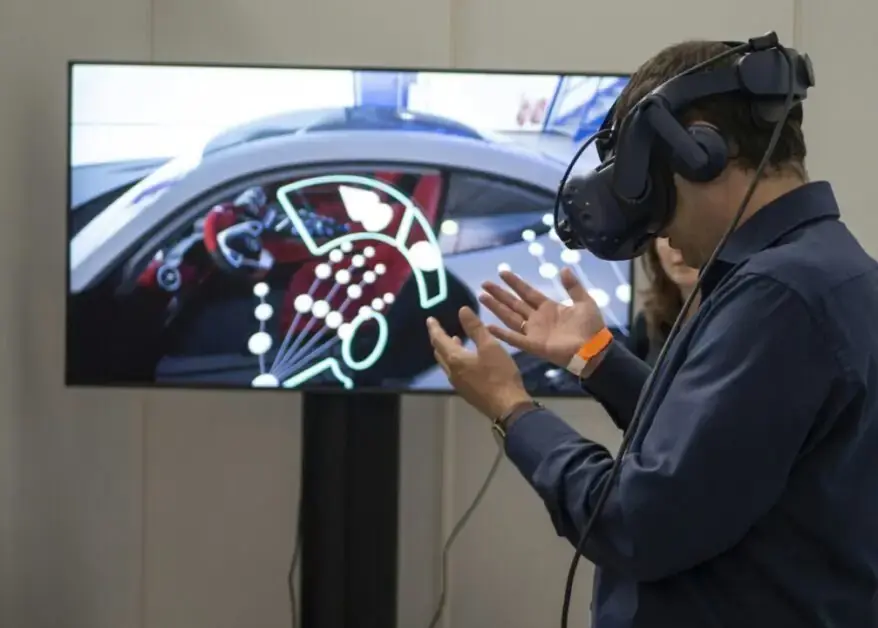Augmented Reality: Definition, Examples, and its Future
Estimated reading time: 6 minutes
Augmented Reality (AR) enhances real-world environments by providing interactive experiences through computer-generated perceptual information. Moreover, it blends digital content with the real world, enhancing user experiences through interactive visual and sensory overlays on physical spaces. Additionally, AR systems utilize sensors, such as cameras and GPS, to overlay virtual objects seamlessly onto the physical world. In contrast, unlike Virtual Reality (VR), which immerses users in a completely virtual environment, AR integrates digital information with the user’s surroundings in real-time.
What is Augmented Reality and How Does It Work?
Understanding the Concept of AR – Augmented Reality definition
Moreover, it enriches the perception of reality by superimposing virtual elements onto the real world.
Users can experience a blend of real and virtual worlds through an AR device or application.
Difference Between Augmented Reality and Virtual Reality
In contrast, while Virtual Reality creates a simulated environment, when we define Augmented Reality, we understand that it enhances the existing environment by overlaying digital content. Additionally, AR maintains a connection to the real world, unlike VR, which offers a fully immersive virtual world experience.
AR Applications in Real-world Environment
Specifically, its applications have diverse uses, such as navigation assistance with GPS overlays and interactive educational tools that bring learning materials to life within the user’s surroundings.
Examples of Augmented Reality Technology
Augmented Reality Used in Various Industries
AR technology isn’t just for entertainment anymore.
In fact, it finds applications across industries like healthcare, retail, and manufacturing. Here, AR technology enhances workflows and provides innovative solutions for complex tasks.
AR Applications in Smartphones
Many modern smartphones have AR capabilities. Consequently, users can access AR apps with these devices. Moreover, these apps offer interactive experiences using the camera and sensors, enhancing user engagement and functionality
Immersive AR Experiences
Notably, immersive AR experiences transport users to virtual worlds by seamlessly integrating realistic virtual objects into their physical environment. As a result, they create captivating and interactive scenarios.
Also read: https://entechonline.com/creating-immersive-experiences-the-tech-behind-vr-and-ar-systems/
Future Uses and Applications of Augmented Reality
Potential of AR in Extended Reality (XR)
Extended Reality (XR) combines AR, VR, and MR (Mixed Reality) to offer users a broad spectrum of interactive and immersive experiences. Consequently, it opens up new possibilities for entertainment, education, and professional applications.
AR Enabled Devices and Sensors
AR-enabled devices, equipped with advanced sensors like accelerometers and gyroscopes, are increasingly capable of delivering seamless AR experiences. Additionally, they provide users with enhanced interactions and functionalities.
AR and Location-Based Services (GPS)
Significantly, combining GPS technology with AR is powerful. Moreover, this integration allows for location-based services, enhancing navigation, tourism experiences, and gaming applications. Additionally, digital information overlays real-world surroundings, creating a more engaging and informative experience.
Challenges and Advancements in the Augmented Reality Space
Improving User Experience in AR Technology
Enhancing user experience in AR involves refining interactions between virtual and physical elements, ensuring smooth transitions and intuitive interfaces for seamless AR usage.
Integration of AR with Real-time Data
Seamlessly integrating real-time data into AR experiences enhances the relevance and accuracy of the information displayed, thus creating dynamic and responsive augmented reality applications.
Advancements in AR Hardware and Software
Ongoing advancements in AR hardware, such as AR glasses and headsets, and software development lead to more immersive and efficient AR solutions, expanding the capabilities and usability of augmented reality technology.
Also, read: https://entechonline.com/ar-vr-xr-and-mixed-reality-the-future-of-learning-science/
The Impact of AR on Work and Daily Life
We have defined AR, Enhance Work Processes and Efficiency

They streamline workflows in various industries such as Logistics and Warehousing, Healthcare and Surgery, improving efficiency by providing real-time insights, interactive training modules, and visualization tools for complex tasks.
AR Applications for Education and Training
Moreover, it enhances learning experiences by offering interactive educational content, simulations, and virtual laboratories, so it makes educational material engaging and accessible to learners of all ages.
Augmented Reality in Entertainment and Gaming
Furthermore, entertainment and gaming industries leverage AR technology to create immersive and interactive experiences, blending virtual elements with real-world environments to offer users captivating as well as dynamic entertainment options.
FAQ
Q: What do you mean by augmented reality? Define augmented reality.
A: Augmented reality (AR) is an interactive experience where digital information is overlaid onto the real environment, allowing users to interact with both the physical and digital worlds simultaneously.
Q: How does AR work?
A: AR works by using sensors and cameras on mobile devices to blend digital elements into the real world in real-time, providing users with an enhanced sensory experience.
Q: What is the difference between AR and VR?
A: While both AR and Virtual Reality (VR) offer immersive experiences, it is essential to note that AR overlays digital content onto the real world. In contrast, VR creates a completely virtual environment for users to interact with.
Q: Can augmented reality be used on mobile devices?
A: Yes, you can use AR on mobile devices. Various AR apps allow users to experience AR on smartphones and tablets.
Q: What are some examples of augmented reality applications?
A: Examples of AR applications include shopping experiences, gaming, marker less navigation tools, and even contact lenses for visual enhancements.
Q: How is augmented reality incorporated into daily life?
A: Users can use AR in educational settings, training programs, marketing campaigns, and healthcare simulations. This showcases its versatility and potential uses.
Q: What is the future outlook for augmented reality?
A: AR has become increasingly complex and seamlessly integrated into various industries. Moreover, it shows potential for further advancements in mixed reality experiences and interactive consumer technologies.
References
- Harriman, D., et al. (2002). Tools for gps b-rnav. Journal of Navigation, 53(3), 403-411. https://doi.org/10.1017/s0373463300001016
- Sural, I. (2018). Mobile augmented reality applications in education. Virtual and Augmented Reality, 954-969. https://doi.org/10.4018/978-1-5225-5469-1.ch045
Additionally, to stay updated with the latest developments in STEM research, visit ENTECH Online. Basically, this is our digital magazine for science, technology, engineering, and mathematics. Furthermore, at ENTECH Online, you’ll find a wealth of information.
Disclaimer: This blog post is not intended to provide medical advice. Please consult with a healthcare professional before making any changes to your diet or lifestyle. AI-generated images are used only for illustration and decoration. Their accuracy, quality, and appropriateness can differ. Users should avoid making decisions or assumptions based only on these images.
